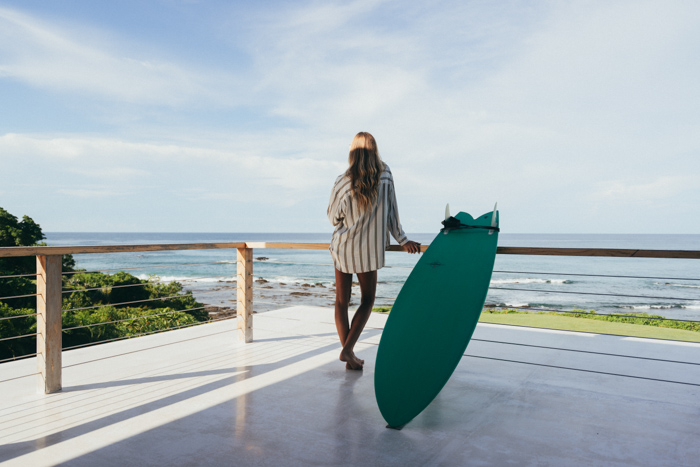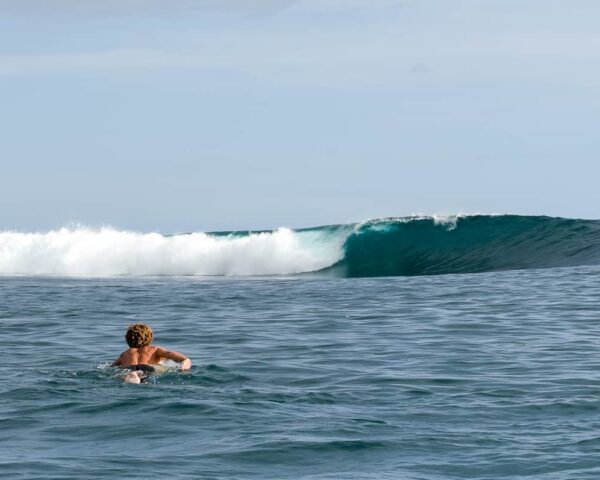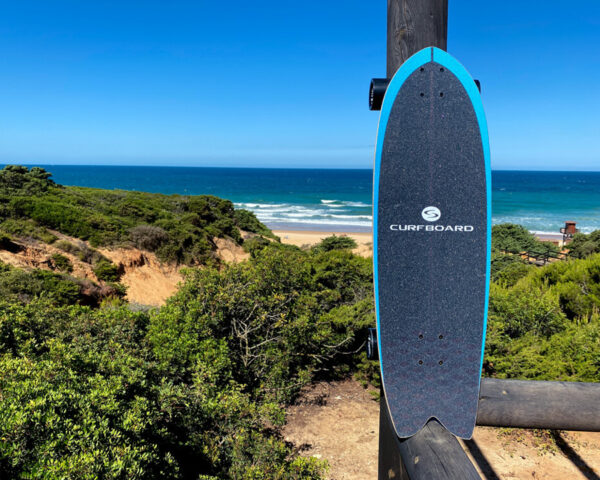
Aside from the actual waves we ride, nothing captures our attention as surfers more than our boards. Surfboards hold a nearly mythical place in our funny little subculture, and the various designs that have evolved over the years are as much part of the history of surfing as the people who rode and shaped them. But as renowned shaper Dan Mann once said, surfboards are simply planing vehicles for our fins.
It’s the fins that enable our boards to turn, that allow us to ride with control in the pocket (and deep in the barrel!), and that provide the thrust and drive our boards need to accelerate around sections. Our fins might just be the most important part of our surfboards, and yet they seem to receive less attention than virtually any other aspect of board design.

Part of the reason that we often overlook surfboard fins in favor of things such as template outline, rocker, and rails might be because they are so damned complex and difficult to understand. There are a dozen things going on with surfboard fins at any given time, and they all work together to make our boards go.
But what do all of these characteristics mean, exactly? What is toe, cant, foil, and rake? Why do quads go faster than thrusters, and why do some boards come with glassed-on fins and others with removable fin systems? What about construction, materials, weight, flex, and all of the other esoteric topics we hear experienced surfers and board designers discussing?
We’re going to demystify all of these various aspects of fin design, explaining what each is and how it affects the performance of your board. Whether you are searching for a new set of quads for your summer shortboard or debating between buying a single-fin mid-length or a keel-fin fish surfboard, read on to learn more about what exactly makes surfboard fins tick.
Fin Design Elements

Size
The easiest characteristic of a fin to understand is size, because this is a concept that is not only familiar to us, but also relatively intuitive. Generally speaking, the larger your fins are, the more drive they will produce and the more control they will provide.
However, these advantages come at a cost, as larger fins are more difficult to maneuver through the water. Thus, the best course of action is to find a middle ground and compromise, bearing in mind what type of waves you intend to ride and how big of a surfer you are.
If you are small in stature and intend to do high-performance surfing in smaller waves, you will likely look for a smaller set of fins. On the other hand, if you are a heavier, more powerful surfer and ride larger, hollower waves, you may want slightly bigger fins. The exact size and model you opt for will depend on the combination of all of these factors.
Depth
When it comes to surfboard fins, size is not one dimensional. Instead, there are a number of important measurements to consider, the first of which is depth. Depth refers to how far the fin extends below the water, as measured from the bottom of the board. Fins with greater depth will provide more control in critical sections, but will be more difficult to turn.
Base

Unlike depth, which measures how far the fin extends beneath the surface, base is the length of the fin from the leading edge to the trailing edge, measured along the bottom of the board where the fin attaches. A longer base creates more drive through the water, but will again impact the board’s ability to turn quickly.
Foil
Foil is the third dimension that must be considered when looking at the size of a fin, although it is typically more associated with shape than length. The foil of a fin refers to its contours when it is looked at head-on, and is best described as the width of the blade of the fin.
A board with more foil (that is, a more rounded aspect at the leading edge) will facilitate smoother turns, but will also slow the board down as it moves through the water. A fin with no foil, on the other hand, will go faster, but will tend to break free during turns.
Some side fins have foil on the outside and flat (no foil) on the inside, although many modern fin sets do include some foil on the inside of side fins. Center fins, single fins, and quads all tend to be foiled on both sides.
Modern twin fins also tend to be foiled on both sides, while older twin fin designs were foiled only on the outside face.
Rake
Rake refers to how far the rear tip of the fin extends behind the fin’s base, and is what gives surfboard fins their drawn-back, dolphin fin shape. The purpose of rake is to create stability and increase drive through turns.
However, the more rake there is, the slower and more drawn-out turns will be. Thus, fins with more rake are better for bigger waves or open-faced point breaks, while more upright fins lend themselves to tight-radius turns and barrel riding.
Increased rake is also helpful for turning heavy, traditional longboards.
Toe
When it comes to surfboard fins, toe is the angle at which the fin is aligned in relation to the stringer. Typically speaking, single fins and center fins on thruster setups will have no toe, as they are perfectly aligned with the stringer.
However, side fins in thruster setups, as well as most quads and twin fins, will have a few degrees of toe in which the front of the fin is pivoted in toward the stringer slightly, with the trailing edge of the fin pointing slightly toward the rail.
When the fins are turned in like this, water pushes on their outer sides while moving through the water, making the board looser and more maneuverable. Too much toe will cause a board to be overly loose and lack drive, while boards with no toe at all will be harder to turn.
Toe also affects how a board rides through the water in relation to the tip-to-tail axis. Less toe will keep the board on a more even plane, while more toe will lift the nose out of the water. Modern shortboards are typically designed with around three to four degrees of toe in the side fins.
Cant

Cant is the measure of the angle at which a fin tilts away from the base of a board. A fin with zero cant stands perpendicular to the board’s base, which is the alignment used for single fins and center fins.
Side fins typically have a few degrees of cant (typically between 5 and 7 degrees), with the fins leaning slightly outward toward the rails. Like toe, cant affects a board’s drive and ability to turn, with less cant making for a faster board, and more cant making a board looser.
Outline
A fin’s outline has a noticeable impact on its performance, as discussed earlier in the sections on rake, base, and depth. While there are theoretically an infinite number of size and shape combinations that you could use for surfboard fins, a handful of outline shapes have stood the test of time and proven to be most effective with surfboards. These include:
Rake fin

An extremely general category of fins, rake fins are pretty much any design that includes rake in the outline. As discussed previously, rake increases drive and the ability to turn a board, but also causes turns to be longer and more drawn out. George Greenough is widely credited with inventing a tuna-fin-style rake outline that has largely influenced most modern surfboard fins today.
Flex fin
A flex fin is simply a rake fin with flex built into it (through intentional layering of fiberglass or other materials) in order to cause the fin to snap back into position after being placed under load during turns. Although most fins have some degree of flex built into them, true flex fins tend to be larger (six inches of depth or more) and used with mid-lengths and longboards. George Greenough is also widely credited with bringing the flex fin into widespread use.
Pivot fin
Pivot fins have a fuller, more vertical outline, and are typically long (with as much as 9 and 10 inches of depth) and rigid. These fins slow a board down and provide a lot of stability, which makes them ideal for noseriders. However, they are typically quite difficult to turn, which is one of the many reasons traditional noseriders are difficult for beginners to ride.
D fin
The original surfboard fin design, a D fin is exactly what it sounds like—a large D-shaped fin with lying on its back and aligned with the stringer. This classic single-fin shape is good for maintaining trim and stability, but is less maneuverable than a pivot fin, which is why most traditional noseriders today feature pivots rather than D fins.
Keel fin
Widely used on early twin-fins and the retro fish designs that have seen a resurgence of popularity over the past decade, keel fins are characterized by a long base and a short depth.
Due to their increased surface area and limited drag, keel fins are quite fast down the line. However, they tend to be tracky and somewhat difficult to turn and require more drawn-out turns.
A true retro fish will feature traditional keel outline (which features a straight trailing edge), but modern keels cut away some of the trailing edge, effectively adding a bit of rake and increasing maneuverability.
Fin Setup

In addition to the various design aspects that go into selecting a fin, it is also necessary to decide what fin setup you will use for your board. There are a number of different popular setups, including single fins, twin fins, twinzers, thrusters, quads, Bonzers, and five-fin setups with a small trailer fin. Each has its pros and cons, and each works best with specific types of boards and waves.
Single fin
The first fin setup used on surfboards was a single fin, and surfing legend Tom Blake is credited as being the first person to affix a skeg to a board. Single fins provide a classic feel, trimming well in the pocket and giving a board a lot of stability, which makes them great for traditional noseriders and retro-influenced boards such as mid-lengths. However, they tend to be slower and less maneuverable.

Epic surf trips made easy.
Explore luxury done-for-you surf vacations with Lush Palm Private Retreats.
If you are looking to spend all day on the nose, tap into the flow of the 1960s, or challenge yourself with a throw-back design, single fins are the call.
Twin fin
In the early 1970s, shortly after the Shortboard Revolution took over surfing, the twin fin was the next step in performance evolution. Surfer/shapers such as four-time world champ Mark Richards built short, stubby twin fins that were essentially refined versions of the fish design, and skated their way to victory in the small, soft venues of the world tour.
While single fins were still preferable for larger waves and barrels (due to their stability), twins allowed boards to go faster and be surfed more radically, and in many ways were the precursor to today’s modern high-performance surfing.
A twin fin setup is great for retro fish designs, small-wave grovelers, or any time you simply want to feel something looser and skatier.
Thruster
When Simon Anderson revealed his thruster setup at a pro contest in 1981, it was one of surfing’s pivotal moments. In huge, historic Bells Beach, his three-finned boards absolutely dominated a field that was largely handicapped by short, squirrelly twin fins and slow, archaic single fins.
The thruster became the go-to design virtually overnight, and remains the most commonly used setup today. Essentially a compromise between a twin fin and a single fin, the thruster features three similarly sized fins, with two side fins and a center trailing fin aligned along the stringer.
This setup provides some speed created by the thrust generated by the side fins, but also provides stability and control due to the center fin. The result is a fast, aggressive, top-to-bottom, high-performance board that has become the industry standard for modern surfing.
Quad

An attempt to add stability and control to the traditional twin fin setup without sacrificing the speed that came from a lack of center fin drag, quads add an “extra” fin to each side of a twin-fin setup, set just back and inside of the main side fins.
Quads were first invented in the 1970s, but were largely forgotten until the early 2000s, when they made a major resurgence. Today, most boards with removable fin systems come stock with five boxes so that you have the option to ride them as thrusters or quads.
Quads are much faster than thrusters, but can be surfed a bit more aggressively and top-to-bottom than twins, making them a great compromise. Many big wave riders prefer their guns as quads, as do barrel-chasers who are riding fast, down-the-line sandbar tubes. Quads are also a great option if the waves are a bit too soft to provide the necessary speed to a thruster.
Twinzer
A compromise between the twin and the quad, a twinzer is simply a twin fin with two small fins just forward and toward the rail from the larger fins. In other words, it’s an inverted quad setup with smaller-than-normal extra fins. This provides a bit more speed than a quad, as well as more of the classic twin fin feel, but with slightly more control than a classic twin.
Bonzer
The original three-finned board, the Bonzer, was invented by Duncan and Malcolm Campbell in the late 1970s, before Simon Anderson started tinkering with the thruster concept, but struggled to catch on and was eventually overshadowed by the thruster.
Featuring larger single fin and two long, triangular side fins, the Bonzer is stable and fast in larger waves, and remains popular with a small subculture of retro throwbacks.
Modern Bonzers have replaced each triangular side fin with two staggered half-moon fins, technically making it a five-fin board (although it still surfs much like a three-finned board, since the two half-moon fins work together as one unit.
Five fin (quad with trailing fin)
True five-fin boards are extremely rare, and have not gained much popularity over the years, despite Kelly Slater competing on them in a few world tour events.
The concept is basically a quad setup with a small trailing center fin, which adds a little more stability and control without completely negating the quad’s speed (since the drag of the small center fin is reduced due to its size). This is considered by most people to be little more than a novelty setup, although technically any modern board with five fin boxes can accommodate it.
2+1

Favored by those looking for a more user-friendly, performance feel on longboards and mid-lengths, the 2+1 is essentially normal-sized side fins (or, alternatively, smaller “side bites”) with a large single fin box in the center. This provides a bit more speed than a traditional single fin setup, in addition to the ability to turn more aggressively.
Brands

As if design aspects and fin setups weren’t enough, you will also have to decide which brand to buy your surfboard fins from. The different fin brands use different fin box systems, so it’s typically a good idea to have the same system on all (or at least most) of your boards so that you don’t have to buy multiple fin quivers from different brands.
The exception here is single fin boxes, which are standardized across all brands (in other words, you can use a single fin from just about any fin brand in any board that has a single fin box).
The industry leaders for removable fin box systems are Future and FCS, while a few of the more popular single fin companies include Rainbow, Flying Diamond, Captain Fin Co., and True Ames.
Future
Utilizing a fin box that houses the entire base of the fins, Future had a reputation as having a stronger system that was less likely to break than its main competitor, FCS. Today, that advantage has been mitigated somewhat by the FCS II design, but Future remains one of the world’s leading fin companies, with dozens of fin designs in a number of different materials, including a number of celebrity pro and shaper signature models.
FCS

The first removable fin box system to go mainstream, FCS has recently updated its design so that the tabs on the base of the fin (which lock into the boxes) are larger and less likely to break. FCS II fins also have the advantage of snapping into place without a screw, which some people prefer. Like Future, FCS has a wide range of fins and materials, including a number of celebrity signature models.
Rainbow
Founded in 1968, Rainbow Fins enjoys an industry-wide reputation for quality. Although originally started to build single fins, Rainbow now has a wide range of thruster, quad, and twin setups as well, which are compatible with a number of fin box systems.
Flying Diamon
Distributed by Carve Sports and featuring lines of fins from celebrity longboarders and board designers such as CJ Nelson and Taylor Jensen, Flying Diamond has established itself over the past decade as a leader in the traditional single fin sector. Flying Diamond also offers a number of side fins for 2+1 setups.
Captain Fin Co.
Enjoying widespread popularity with the traditional longboarding and “hipster” scene, Captain Fin Co. combines time-tested designs with quality fiberglass craftsmanship. The company has recently expanded to include thruster, quad, twins, and keel fin setups.
True Ames
Established by Chuck Ames in 1979, True Ames has grown into a quality boutique fin brand that builds everything from single fins to modern thruster and quad setups.
Glass-ons
While the majority of boards feature removable systems these days, some shapers still offer glass-on options for those who prefer the feel. Glass-on fins make it more difficult to travel with boards and obviously don’t offer the flexibility of trying a variety of different fins on each board, but tend to feel a bit more dependable, particularly on boards built for bigger, more hollow waves.
Summary

As you can see, there is a lot that goes into those little pieces of fiberglass sticking out of the bottom of your surfboard! If you have made it this far without falling asleep or becoming completely confused, then you have likely developed a pretty comprehensive understanding of how surfboard fins work, why they are important, and what you need to consider when choosing fins for your various boards.
Once you choose a fin system for your quiver, consider demoing a number of different surfboard fins on different boards to get an idea of how each set feels and affects the board’s ride. To make things easier on yourself, refer to your fin company’s purchase guide, which will typically give you guidance on the size and style of fin that is best for a surfer of your size and ability, as well as for the type of waves and board you typically ride.
But don’t overthink it too much—remember, there are people out there absolutely ripping on boards such as alaias, which don’t have any fins at all!
Ultimately, your fins are intended to make your surfboard go down the line and turn, which means they are built to help you have more fun! So grab a set, screw them in, and get out in the water. It’s time to shred!







